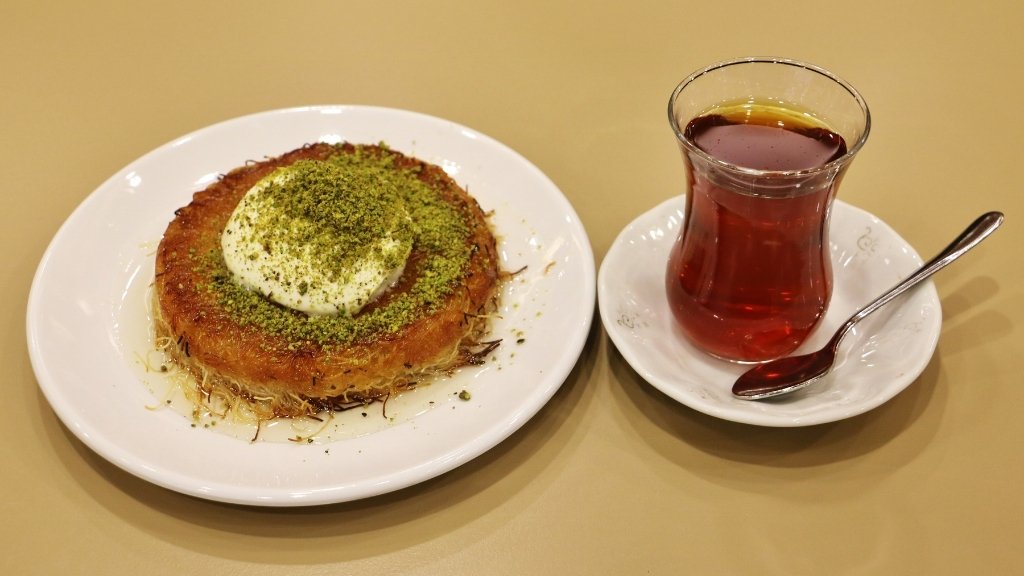Once you enter a Turkish house, the first thing you hear will be the soft whistle of a boiling kettle, even before you manage to sit. That is not routine; it is ritual. Turkish tea is not just a beverage; it is an everyday demonstration of hospitality, a friendly handshake in liquid form. Drunk in dainty glasses shaped like tulips, tea flows through the lives of Turks, accompanied by quiet breakfasts and late-night conversations under the shining lights, always with a sense of connectedness.
This guide will take a closer look at the history of Turkish tea, its rich brewing traditions, varieties, and its cultural significance, going far beyond being just a national beverage. As a curious traveller or tea lover, this trip to the most popular Turkish ritual has something to offer you.
My Story: 10 Years of Living the Tea Tradition in Turkey
I spent 10 memorable years in Turkey, and there was only one tradition that could truly be called a way of life: Turkish tea. Every morning, the sound of the çaydanlık warming on the stove and the deep aroma of steeping tea became part of my routine. Being with friends, waiting at a barber, or passing through a bazaar, somebody was always ready to offer you a glass of hot, freshly brewed tea. The thing that struck me the most was that the tea was not only about the taste but also about the connection it fostered. Tea was like a passport, a friendship maker, and a home away from home, even though you were miles away.
The Historical Roots of Turkish Tea
How Tea Came to Turkey
I lived in Turkey for 10 years, and one of the things I noticed is how much tea is part of life there, but its history is less ancient than many people think. Although tea had been imported to other countries through the ancient trade routes from China, it was only in the early 20th century that it was established in Turkish culture. Coffee was too costly to import after World War I, and tea was the ideal local substitute.
Mustafa Kemal Atatürk (First President of Turkey – 1923-1938) actively promoted tea drinking as a national habit, helping transform it into Turkey’s most beloved beverage.
Rise of the Rize Region
I also had the opportunity to travel to Rize, which is the center of Turkish tea production on the Black Sea coast. It has a rainy climate and fertile soil conditions that make it ideal for growing tasty black tea. As I strolled through its lush plantations, I got a glimpse of how the local economy thrives on tea farming, not only as a product but also as a source of pride. And yes, Turkey is indeed the world leader in the number of people consuming tea per capita. After living there, I am not surprised.

Lush green tea fields in Rize, Turkey – the heartland of Turkish tea production.
What Makes Turkish Tea Unique?
Mastering the Çaydanlık: The Art of Brewing Turkish Tea
During my 10 years in Turkey, I soon discovered that Turkish tea is not just about the beverage, but a tradition and an art form. The çaydanlık, a double teapot system, is the heart of it all. The lower kettle is used to boil the water, and the top creates a concentrated mixture of tea. This lets everyone adjust their cup to taste – açık (light) or koyu (strong). And here is one of the things I learned early in life: never pour boiling water directly over the leaves. Allow it to steep gradually to bring out the smooth taste without bitterness.
Symbolism in a Glass: Tulip Shapes & Serving Rituals
Another thing that impressed me was the visual beauty of tulip-shaped glasses. They are not only visually appealing, but they also bring out the rich, deep red color of the tea. I’ve heard that refusing a cup of tea in Turkish culture is considered somewhat rude, and it happened to me as well. In any setting, whether at home, the office, or a shop, being offered tea is a welcome sign of respect.
Aroma, Taste & Emotion: The True Flavor of Turkish Tea
Turkish tea has a unique taste; it is, at once, powerful and bitter, yet pleasant, with a soothing aroma. It is taken by most people, plain, or with a cube of sugar, but never with milk. What is memorable is not only the taste but also how it unites people. This small glass has a century of culture in every drop.
Types of Turkish Tea You Should Know
Having spent more than ten years in Turkey, I have been fortunate enough to delve into every aspect of Turkish tea culture. Whether in the busy tea gardens of Istanbul or in the village houses of the Black Sea area, Turkish tea is not a drink but a way of life. There are the following main types of Turkish tea that every tea-lover must be aware of.
1. Black Tea (Traditional Çay)
This is the heart of Turkish tea culture. It is made strong with loose-leaf black tea of Rize, and drunk in a tulip glass all day. This black tea is present either at a family breakfast or at a shop meeting. I found that the authentic taste is achieved when it is steeped slowly and carefully in a double teapot.
2. Apple Tea (Elma Çayı)
Turkish Apple Tea is a sweet, fruity mix that is served to tourists, although it is not a drink that Turks typically consume daily. It is non-caffeinated and is usually drunk in bazaars or hotel lobbies. It’s more of an indulgence than a ritual, but it’s worth sampling if you’re in the mood for something light and spicy.
3. Herbal Teas in Turkish Culture
I have, over the years, resorted to herbal teas such as sage, linden, chamomile, and rosehip, particularly during the winter months. The residents consume them to stay healthy, aid digestion, alleviate a cold, or unwind. They are typically freshly prepared from dried leaves or flowers and are not sweetened.
👉 And when the weather gets warm, many locals switch to Turkish iced tea – a bold yet refreshing alternative that’s perfect for hot summer afternoons.
4. Regional Tea Styles
When I was traveling in Eastern Turkey, I found that people preferred stronger, heartier brews—the ones that would wake you up. On the contrary, those in Western cities tend to prefer mild tastes and are often seen savoring their tea slowly in cafes. Regions with access to the sea, such as the Aegean, incorporate fresh herbs like mint or thyme, adding a local flavor to the traditional method of brewing.
Turkish Tea Culture and Its Deeper Meaning
After 10 incredible years of living in Turkey, I have witnessed firsthand how much Turkish tea is a part of daily life. It is not only a hot beverage, but a strong social practice which conveys trust, care, and connectivity in all walks of life.
A Symbol of Welcome and Respect
Whether you are in a corner shop, at a business office, or in someone’s home, being invited to have a cup of tea is a real sign of hospitality. I’ve been welcomed with a tulip glass of çay by everyone from local grocers to new neighbors. Serving tea demonstrates hospitality, courtesy, and even friendship in the Turkish culture without uttering a word.
Tea Gardens: Where Life Slows Down
The traditional çay bahçesi (tea garden) holds a special place in Turkish social life. I spent so many evenings in the shade of leafy trees, drinking black tea with friends and watching the world go by. Whether near the Bosphorus or in a quiet city park, these spots invite people of all ages to pause, connect, and enjoy the moment.
Daily Rituals and Emotional Bonds
In Turkey, tea has not been a special occasion drink, but rather the best of the day. Whether it’s a quiet morning, the after-lunch break, or serious conversations at night, tea brings people together. That is the way generations tell stories, celebrate life, or take a breath in a busy world. Having spent ten years in this tradition, I can confidently state that tea in Turkey is comfort in a glass.
How to Make & Enjoy Turkish Tea Like a Local
Brewing Turkish tea the traditional way has become second nature to me after I spent ten years of my life in Turkey. It’s not about making a hot drink; it’s a silent ritual that unites people. Brewing it correctly is a significant difference, whether you are at home or in a teahouse full of people.
Brewing with a Çaydanlık (Double Teapot) To brew tea the Turkish way, you’ll need a çaydanlık, the traditional two-part teapot. Here’s the method I followed almost daily:
- Boil Water (Bottom Pot): Start by filling the lower kettle with water and bringing it to a boil.
- Add Loose Leaves (Top Pot): Place about 2 tablespoons of loose-leaf black tea in the top kettle.
- Steep Slowly: Pour boiling water from the bottom into the top kettle over the tea leaves. Let it steep for 10–15 minutes.
- Mix to Your Strength: When serving, pour a bit of the strong tea into a tulip glass and dilute with hot water to your preferred strength.
Tea Etiquette You Should Know
Tea is served as an expression of hospitality in Turkey, and it is rude to refuse. A few basic but valuable rules that I have picked up over the years:
- Always Accept Tea: Even if you’re full, saying yes shows respect.
- No Milk Allowed: Turkish tea is always served plain – never with milk.
- Gentle Stirring: Stir quietly and avoid using too much sugar to preserve the authentic flavor.
Snacks That Pair Perfectly with Turkish Tea
A cup of Turkish tea is rarely served alone. These are the most usual and favorite combinations of mine that I have nearly every day:
- Simit: A sesame-coated bagel – perfect for breakfast or tea time.
- Baklava: Rich and sweet, it balances the tea’s boldness.
- Turkish Delight: A chewy, fragrant candy often offered to guests.
- Börek: Flaky pastry filled with cheese, spinach, or meat – a savory classic.

FAQs About Turkish Tea
What is Turkish tea made of?
Turkish tea is prepared with top-quality loose-leaf black tea, most of which is produced in Rize, a green area on the Black Sea. It’s traditionally brewed using a çaydanlık – a double teapot that allows for slow steeping and layered flavor. Having spent 10 years in Turkey, I can attest that the key to genuine taste lies in the quality of the leaves and the time spent brewing.
Is Turkish tea healthy?
Yes, Turkish tea is considered a healthy beverage when consumed in moderation. It is also naturally high in antioxidants, which can also promote cardiovascular health and strengthen your immune system. Although it has caffeine, it is moderate compared to coffee; that is, it is not so much that it will make you jittery, but just enough to give you a mild boost.
How many cups of tea do Turks drink per day?
My personal experience in Turkey has shown me people drinking tea throughout the day. The majority of locals consume between 3 to 7 or 8 cups a day, usually during mealtimes, at work, or when chatting. It is not just a drink, it is a rhythm of life.
Can I make Turkish tea without a çaydanlık?
Yes, it’s possible to brew Turkish tea without a çaydanlık, but you may miss out on the full flavor and cultural experience that comes with it. Using two separate pots can mimic the same effect. Still, for the most authentic brew, especially in terms of aroma and depth, a çaydanlık makes a noticeable difference.
Does Turkish tea have caffeine?
Yes, Turkish black tea has caffeine, but in a much smaller amount than a cup of coffee. It contains approximately half the caffeine of coffee, making it a good choice for a light boost during the day.
My Insight After Living 10 Years in Turkey
“Having spent 10 years in Turkey, I can now realize that Turkish tea is not merely a beverage, but a common language of hospitality, culture, and home. Each cup has a story, whether it is a cup of tea in a busy teahouse or a cup of tea at home. It is a daily event that unites people, spans generations, and is the embodiment of Turkish hospitality.” — Miral Fatima.
Final Thoughts
A dark red color, exquisite taste, and a century of tea traditions make Turkish tea more than just a drink; it is a living embodiment of unity. Having lived in Turkey for 10 years, I now realize the importance of every glass as it presents the feeling of community, comfort, and timeless tradition. Whether at home in the comfort of your kitchen or sitting on a balcony in Istanbul with a gentle breeze, you are not merely drinking tea; you are also participating in a lovely cultural tale that is still alive and present today.
👉If you’re interested in exploring Turkish family life and how traditions shape everyday living, I recommend checking out my detailed guide on family life in Turkey, which beautifully connects with the cultural role of tea.

Hi, I’m the heart behind Turkish Aura. I lived in Turkey for 10 beautiful years, where I fell in love with its tea, traditions, and soulful way of life. This blog is my way of sharing real stories, cultural wisdom, and personal experiences to help you feel the true essence of Turkish culture – just like I did.Thank you for being here, and love you!



